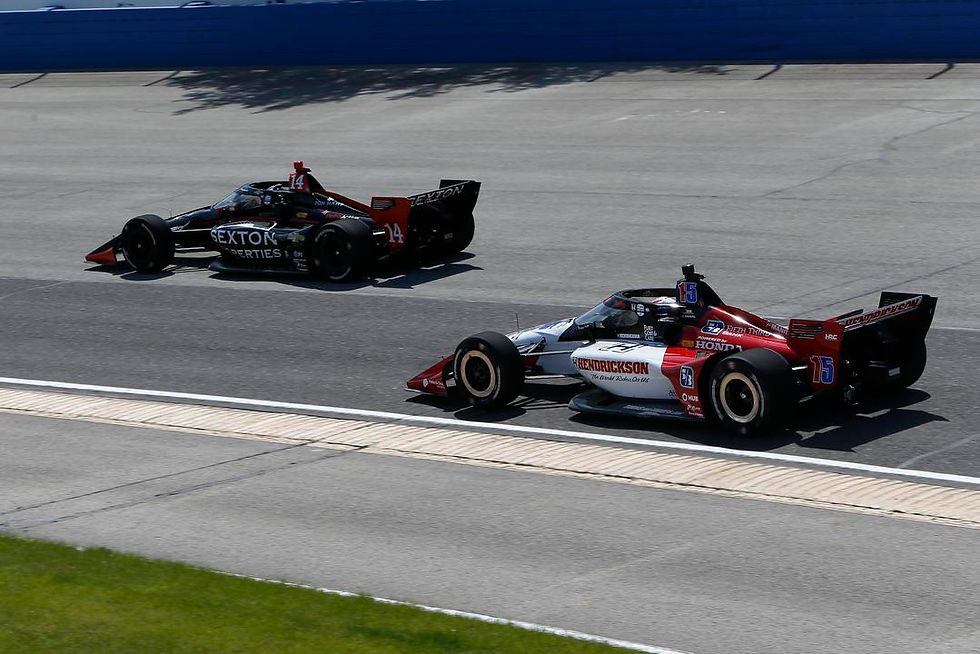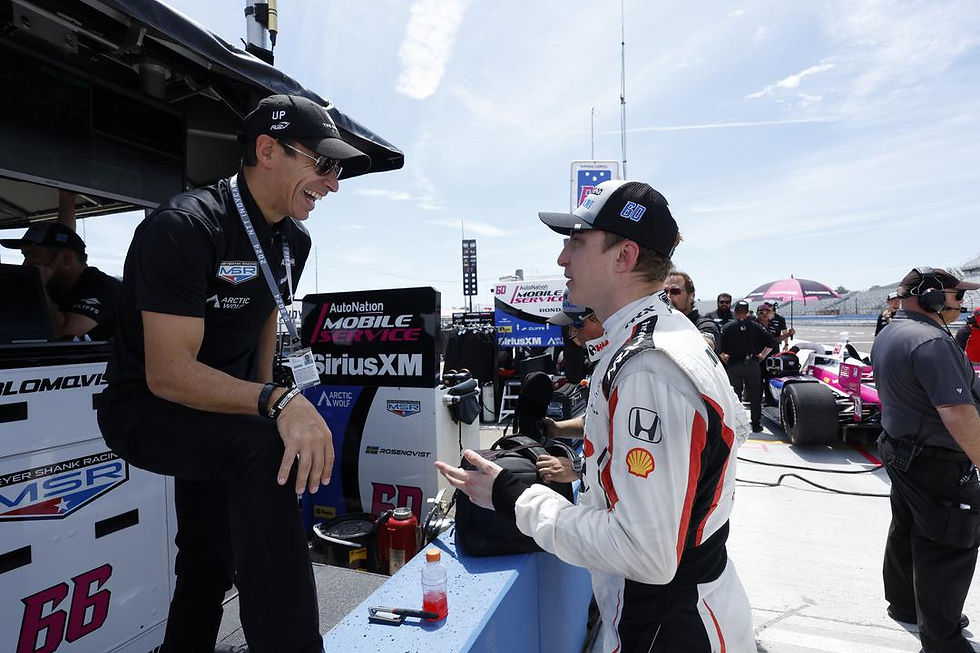Written by Archie O’Reilly
The NTT IndyCar Series rolled back onto the Milwaukee Mile for a hybrid test on Tuesday ahead of its racing return to the short oval for a late-season doubleheader on August 31 and September 1 after eight seasons off the schedule. There were no major issues reported.
The primary intention of the test day was to continue preparations for the introduction of the new hybrid system, which will be debuted at Mid-Ohio Sports Car Course on the first weekend in July. IndyCar’s hybrid era was initially scheduled to begin in St. Petersburg to start the season before being pushed back until after the Indianapolis 500.
Tuesday’s outing was the first ‘full-field’ hybrid test, albeit with the absence of Chip Ganassi Racing and Juncos Hollinger Racing, who each had drivers unavailable due to participation in the 24 Hours of Le Mans. They will test at a later date.
The day also offered a chance for the Milwaukee track to be tested ahead of the long-awaited return for IndyCar for the first time since 2015. Team Penske’s Will Power and Ganassi’s Linus Lundqvist completed a tyre test on the mile-long track in October but this was an opportunity for a much greater number of cars to be on track.
For teams and drivers, it allowed them to either readapt to or completely learn the track, as well as continuing to become accustomed to the hybrid system, paired with the existing, 2.2-litre, twin-turbocharged V-6 engine.
“It hasn't changed much,” 2014 Milwaukee winner Power said of the track. “I think those patches don't seem to have much grip though in the middle of the corners, which is really good for passing. It’s the same track. It feels exactly like it did. I did really well here. It was one of my favorite ovals. I had been looking forward to coming here.”
The initial plan was to get on track at 9am Central Time (CT) and run for one hour, before half-an-hour of downtime and another hour of running. There would then be another break between 12:30pm and 1:30pm before one final hour of open running for teams.
The latter part of the afternoon would then be dedicated to two hour-long half-field group sessions controlled by IndyCar. The purpose of these sessions was to test certain processes and systems with the hybrid system in place, with race running featuring pace laps, starts, restarts, cautions, red flags and pit stops.
The start of running was ultimately pushed back to 9:55am due to a safety issue with a trackside crossover gate, which saw the first break scrapped and 2 hours 35 minutes of running up to 12:30pm once the track went green. This period was punctuated only by a brief track inspection as 1,679 laps were turned.
Power was atop the speed charts in this extended opening session and was one of four drivers to log over 100 laps. His teammate Scott McLaughlin ran 117 - the most of any driver - and Josef Newgarden also logged over a century of laps for Penske. Christian Lundgaard also notched over 100 laps for Rahal Letterman Lanigan Racing (RLL).
Jack Harvey was the least productive driver with only 44 laps in his No.18 Dale Coyne Racing Honda in the early-day session.
As always during test running, especially an outing intended to test a specific component like the hybrid, the speed charts are largely irrelevant and most likely unrepresentative. Teams will have been running different programmes to put the hybrid through its paces.
But one note from the opening running was the speed of 22-year-old David Malukas - a two-time oval podium-sitter in his two years in the series - as he returned to an Indy car for the first time since injuring his wrist pre-season. He was making his first appearance in Meyer Shank Racing’s No.66 Honda and led the session for a while before finishing fifth.
Another notable participant was Katherine Legge in the No.51 Honda for Coyne off the back of her recent Indianapolis 500 run with the team. She is one of six current drivers - others being Scott Dixon, Ed Carpenter, Graham Rahal, Power and Newgarden - to have series experience on the Milwaukee oval.
The later final hour of free-for-all running saw a further 705 laps turned. Power was the most productive with 74 laps and Newgarden next-closest with 60 run. Alexander Rossi ran a field-low 11 for Arrow McLaren, Rahal 16 for RLL and Colton Herta 20 for Andretti Global.
Only six drivers - Harvey (69), Rahal (90), Legge (92), Rossi (97) and Ed Carpenter Racing duo Ed Carpenter (82) and Rinus VeeKay (99) - did not reach a total of 100 laps across the two sessions of open running.
Tentatively said, a trend did appear to emerge on the speed charts as Penske rounded out the second session and combined speed charts one-two-three - as they did in Indy 500 qualifying and in last weekend’s Road America race. Newgarden led McLaughlin and Power in the second session, which is in keeping with their short oval dominance in recent times.
“You do feel it’s probably going to assist in passing,” Power said of the hybrid unit. “If you’ve got a run on someone, I think it will work.”
Malukas, who was removed from Arrow McLaren’s lineup at the end of April after missing four events due to his injury, backed up fifth place in the first session with seventh in the second. The combined speed chart showed Power leading Newgarden and McLaughlin, with Herta and Arrow McLaren’s Pato O’Ward rounding out the top five.
The two group sessions of race procedure simulation then followed the open running to conclude the test day. The opening group completed its running without issue, though forecasted rain interrupted the second group after only 12 laps. Running later resumed and was completed.
It is now less than one month until the hybrid unit makes its competition deut at Mid-Ohio, with its first oval outing coming in the two races at Iowa Speedway the following weekend. A total of 3,563 laps being run on the mile-long Milwaukee oval - all sessions combined - is a positive addition to the prior 23,518 miles of hybrid test running.
“This was another important milestone for the IndyCar hybrid power unit,” IndyCar president Jay Frye said. “Chevrolet and Honda checked a lot of boxes today, and none of it could happen without the continued partnership and support of our drivers and teams.”
The heavy-lifting during the majority of the rigorous hybrid testing programme has been done by Penske, Ganassi, Arrow McLaren and Andretti since the latest bulk of testing commenced last August. The remainder of teams got their first and only other taste of the system ahead of Milwaukee on the Indianapolis Motor Speedway road course in late March.
Testing has also taken place on the Indianapolis Motor Speedway and World Wide Technology Raceway ovals, as well as on the Barber Motorsports Park, Road America and Homestead-Miami Speedway road courses. The bumpy Sebring International Raceway was used to simulate street course conditions.
The aim of the hybrid unit is to further elevate IndyCar’s competitiveness, with a new ‘overtake’ option for drivers through the regeneration of energy for redeployment. Energy can be regenerated through braking, throttle position or manual regeneration via selected steering wheel paddles and buttons, with deployment then possible through a button.
On ovals, where braking is not a factor, the alternative means of regeneration will have to be used in order to build the stored energy for drivers to redeploy as they wish. On road and street courses, time-limited push-to-pass will continue to be available alongside the ability to deploy the additional horsepower through the hybrid unit, which has a per-lap limit.











Comments